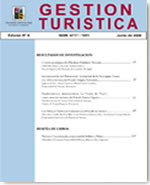MODEL FOR ANALYSIS OF TOURISM OBSERVATORIES (TO) WITH THE CAPITAL SYSTEM (CS)
Main Article Content
Abstract
Tourism Observatories (TO) operate in several countries, having their implementation recommended by the World Tourism Organization (UNWTO). Despite its growing importance as a Destination Management Organization (DMO), TO have still been poorly studied and research that sought to understand their nature and the relationships they develop with tourist destinations is rare. To contribute to overcoming this gap, a model for the analysis of TO was proposed based on the Capital System (CS) and built from the study of 39 TO from 10 countries in Europe and Latin America. The research is exploratory-descriptive, used a mixed method in a convergent project that integrated qualitative and quantitative research and covered content analysis, interviews, application of questionnaires by e-mail and survey. As a result, it presents a model for analysis validated with 29 OT which identified the occurrence of configurations of TO and the relationships established by them with characteristics of the destinations in which they operate.
In addition of contributing to a better theoretical understanding of the object, the model also demonstrated potential to become a viable tool to assist governments and professionals in the sector to manage OT or their networks.

